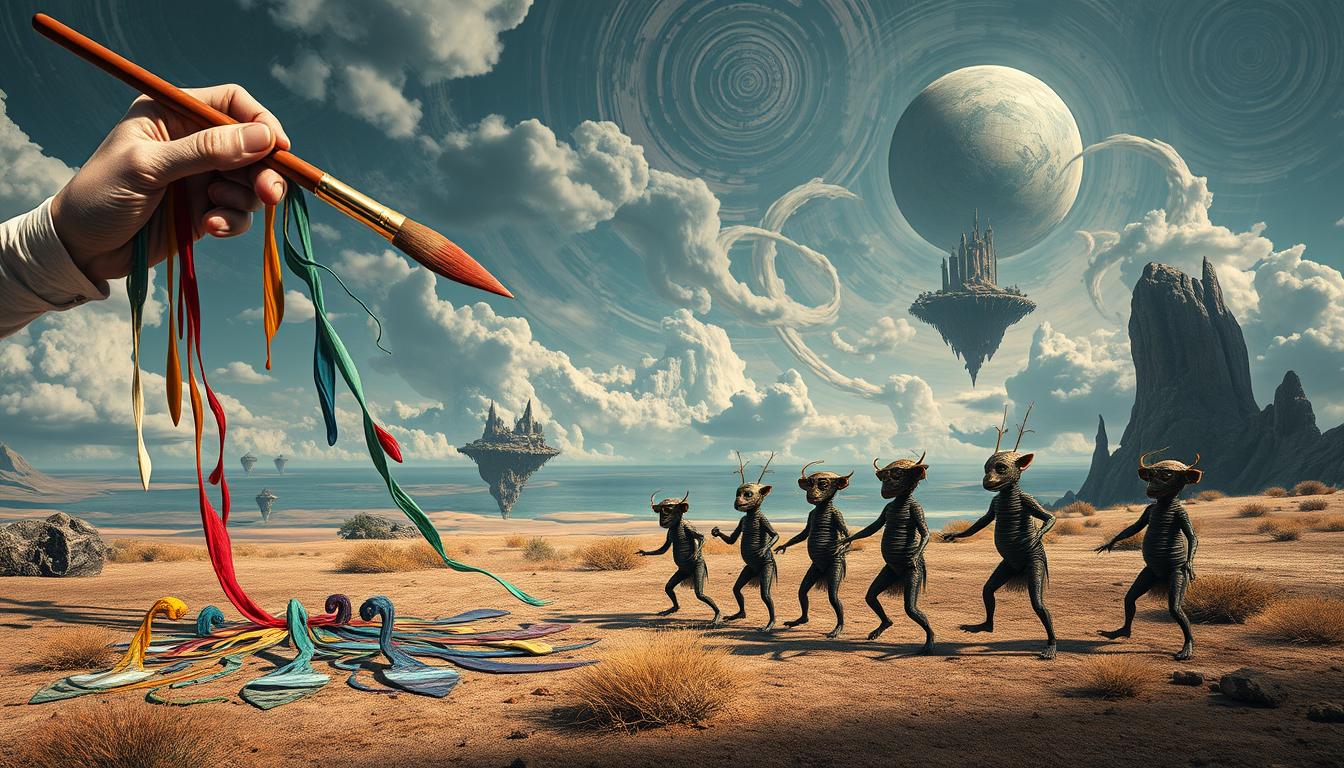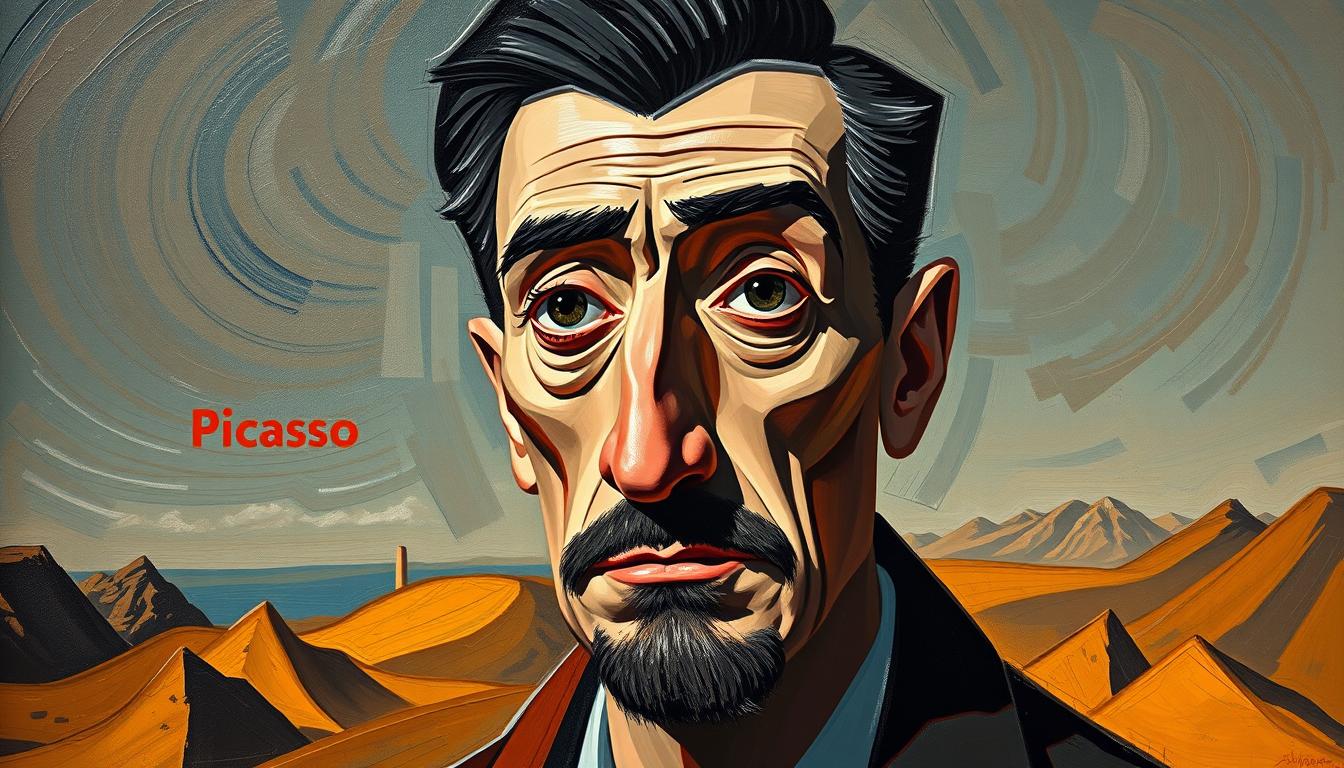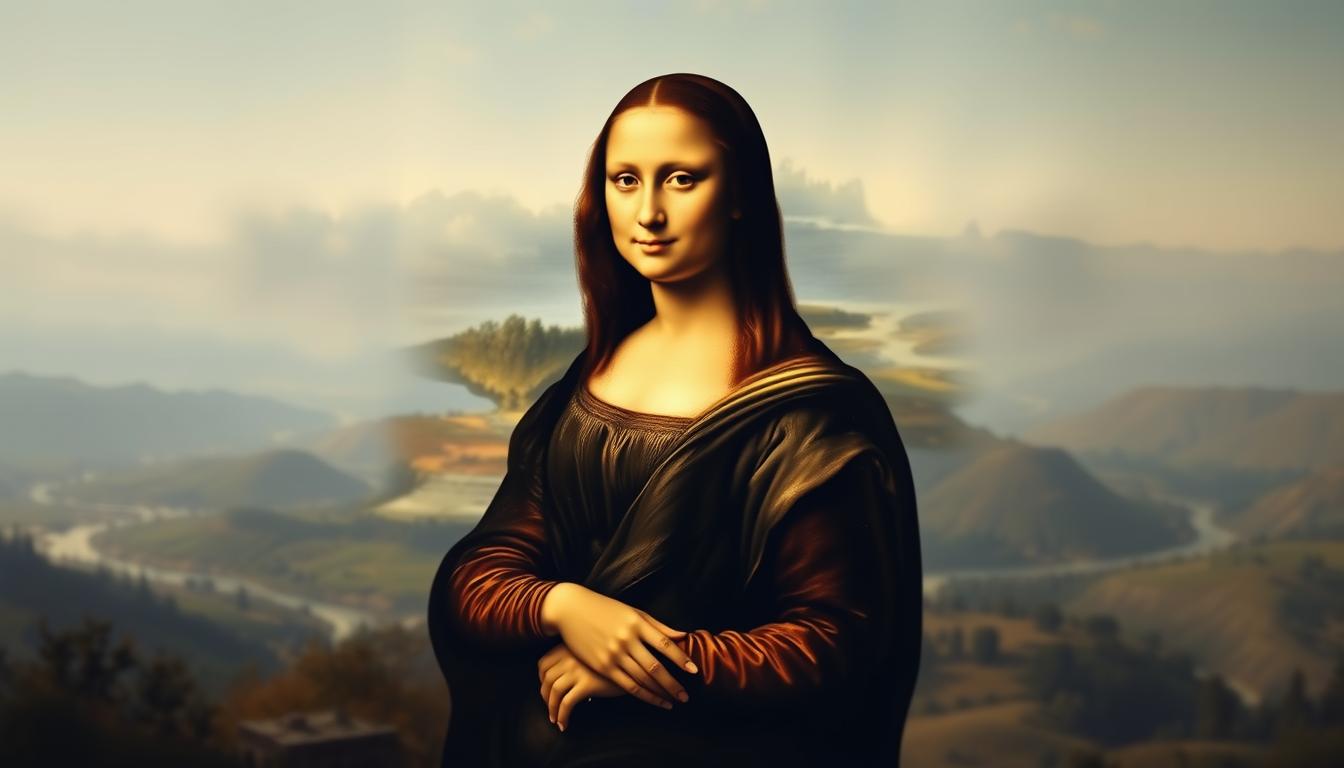Can a painting comfort us about death while also making us laugh at meaning? That question stops you. It pushes you to look closer at images and ideas.
Surrealism often stitches dream logic to a canvas. It creates wonder, loneliness, and a private kind of unease.
By contrast, the philosophy-driven absurd probes a clash: humans crave purpose while the world stays silent. Camus argued that this clash can still leave room for stubborn joy.
Think of Rothko’s claim that tragic work faces death. Think of Becker and Lifton on culture and symbolic immortality. These ideas show why both currents respond to doubt about life.

This guide will trace early twentieth-century dreamscapes to postwar existential scenes. We’ll name artists, explain key forms, and give a practical vocabulary so readers and artists can judge works with more confidence.
Key Takeaways
- Two currents, one aim: both reply to mortality but use different tools.
- Dream logic reveals inner psychic truth; absurdism tests purpose against silence.
- Rothko, Dalí, Magritte, and Camus anchor abstract claims in real work.
- Understanding form and idea helps decode images, themes, and artists’ intent.
- By the end, you’ll have clear terms to discuss meaning in the wider world.
The Ultimate Guide at a Glance: Why This Difference Matters Today
Contemporary culture blends uncanny imagery with comic despair to reflect modern life. This short guide gives a clear, practical map so readers can spot those moves fast.
User intent and what you’ll learn
Your goal: find a quick way to separate dreamlike vibes from existential failure. Over a short time, you’ll get crisp definitions, examples, and takeaways for a curious audience.
We outline the forms artists use and the main ways those forms signal intent. By the end, readers will know how to read painting, prose-poems, collage, and stage experiments.
How this guide uses art, philosophy, and modern media
We mix close readings, philosophical context, and pop-culture examples from late-night cartoons to dystopian shows. That blend shows how each approach works in practice.
This guide serves students, creators, and casual viewers who want a clear purpose when they judge images or scenes. Expect simple checkpoints to use in the wild and one practical way to test what you see.
Origins and Worldviews: From Surrealism to the Philosophy of the Absurd
Early 20th-century upheavals pushed artists and thinkers to rework how meaning forms in a fractured world.
Surrealism’s rise and automatism
Surrealism grew in the early century as artists used automatism to tap the unconscious. They wanted images unfiltered by planning or polite taste.
Freud later argued many works still bore traces of the ego. That critique helps explain why methods shifted across years of experiment.
Existential shifts and Camus
Existentialism nudged Europe from shared dogma toward individual responsibility. Artists adopted doubt, dread, and new freedom.
"The absurd lies in the confrontation between the human need and the unreasonable silence of the universe."
Camus framed absurdism as a man seeking clarity who meets a mute universe; myth sisyphus became a symbol of revolt and acceptance.
Death, meaning, and symbolic immortality
Becker and Lifton argued much creation answers death anxiety. Art can serve as symbolic immortality—a way to push continuity beyond death.
| Origin | Primary Method | Key Thinkers | Core Driver |
|---|---|---|---|
| Early 20th century | Automatism, dream imagery | Breton, Dalí, Freud (critic) | Unconscious and psychic truth |
| Mid-20th century | Essay, myth, revolt | Camus, Kierkegaard | Rift with a silent universe |
| Cross-century response | Symbolic creation | Becker, Lifton | Addressing death anxiety |
Core Features and Forms: How Each Style Works
Artists use form to steer how a viewer's mind meets odd images and uncanny moments.
Dream logic, juxtapositions, and psychic truth
Surreal works rely on illogical pairings and defamiliarization to bypass reason. Paradox and strange juxtapositions open access to private consciousness.
Freud critiqued pure automatism, while Jung urged making dream content visible. In practice, painting often binds dream fragments into a coherent, unsettling scene.
Confronting meaninglessness and disconnection
Absurd pieces hold disconnection as a method. They keep reason from resolving paradox so the viewer must live with failure or silence.
Some artists strip images down to underline emptiness. Others overstack visual elements to create cognitive dissonance that feels like an argument with logic.
Mediums and methods: painting, prose-poems, collage, performance
Painting often shapes sustained visual paradox; prose-poems use tight sentences to stage strangeness without line-break tricks.
Collage and found text expose associative leaps, making process visible as content. Performance can dramatize the clash of expectation and collapse.
| Form | Typical Method | Effect on Viewer |
|---|---|---|
| Painting | Juxtaposition, dream imagery | Deep uncanny immersion, lasting visual puzzles |
| Prose-poem | Sentence-level surreal detail | Heightened consciousness, immediate oddness |
| Collage / found text | Automatic assembly, visible process | Associative jumps, playful or jarring links |
| Performance | Repetition, silence, staged failure | Embodied disconnection, lived paradox |
Practical cues: if images invite free association and dream recall, they likely aim for psychic truth. If scenes force stalled resolution, they test reason and point toward existential tension.
What is the difference between surreal and absurd art?
One impulse trusts imagination to reveal hidden truths; the other insists existence refuses tidy answers.
Worldview vs. condition: the imaginative vision vs. the existential gap
Surreal practice builds a vivid world of dream logic where image-logic opens possibilities and psychic truth may surface.
By contrast, absurdism describes a condition: humans seek meaning while the world stays mute. That gap becomes the central drama.
Form vs. frame: images and dreamscapes vs. the logic of failure
Look at form first. If paintings or poems use strange juxtapositions and associative leaps, they favor image-driven revelation.
If a work arranges events to show collapse, paradox, or stalemate as the point, it relies on framing to expose failure.
Emotional palette: wonder, uncanny, angst, irony
Surreal scenes often trigger wonder, revulsion, or uncanny curiosity.
Works aligned with absurdism push toward deflation, irony, and a kind of anxious laugh at fruitless attempts to find meaning.
- Core rule: if the idea depends on image-logic that opens doors, it leans surreal.
- Counter rule: if attempts at meaning collapse into paradox, it leans toward absurdism.
- Mixes: many pieces combine both—name which tendency dominates.
| Focus | Typical cue | Viewer effect |
|---|---|---|
| Imaginative world | Dream images, juxtapositions | Wonder, mystery |
| Existential condition | Stalled resolution, paradox | Angst, ironic deflation |
Quick checklist: note whether form or frame drives the piece; ask if the work seeks to open meaning or to show meaning's limits.
Artists, Writers, and Touchstone Works You Should Know
A few landmark creators show how images can bend time, block touch, or recast endless labor as a kind of quiet insistence.
Dalí’s Persistence of Memory: time, decay, and the melting image
The Persistence of Memory (MoMA, 1931) turns clocks into soft matter. Dalí uses familiar objects to signal decay and odd elasticity of time.
Look at texture, shadow, and horizon. These choices make the painting feel both precise and uncanny.
Magritte’s The Lovers: veiled intimacy as a vision of the absurd
The Lovers (MoMA, 1928) stages a kiss blocked by cloth. The masked touch creates revulsion and longing at once.
This image shows a world where connection is staged and denied. Notice composition and the deliberate barrier between figures.
Camus’s Sisyphus: struggle, revolt, and imagining happiness
In The Myth of Sisyphus, Camus asks readers to imagine Sisyphus content. That philosophical frame treats endless labor as a chosen stance.
"One must imagine Sisyphus happy."
Together, these works model different moves: Dalí’s surplus of image, Magritte’s staged paradox, and Camus’s moral framing. Use them when you judge other creators whose work sits between excess and austerity. They also show how themes of death and decay reappear in subtle ways.
Surrealism Today: Pop Surrealism and the “Surreal-Absurd” Movement
A late-20th-century turn opened doors to colorful, popular takes that mixed local traditions with dreamlike play.

Pop surrealism grew in the 1990s as a reaction to cold conceptual shows. It blends comics, street art, and folk motifs so more readers find entry points into strange imagery.
Inclusivity and global blends
This branch embraces many styles from different regions. It resists gatekeeping while keeping craft high. Years of community effort helped scattered voices become a visible scene.
Accessible writing and the surreal-absurd scene
The Mercurius initiative archived 90+ poets who favor short, playful prose-poems. That writing foregrounds accessibility and energizes content for broad audiences.
Why sentence-level surreal still works
Psychoanalytic roots persist: dreamwork now filters through tight sentences. Prose-poems carry uncanny play into everyday language without barriers.
- Practical note: try collage, cut-ups, or visual poems to keep tradition fresh.
- Advice: experiment with approachable formats that still reward depth.
| Shift | Effect | Outcome |
|---|---|---|
| Pop embrace | Wider readers | More participation |
| Curated years | Community | Visible networks |
| Formal play | New media | Vital practice |
Modern Life on Canvas and Page: Tech, Politics, and Everyday Strangeness
As screens shape attention, artists turn familiar scenes into uncanny mirrors for public life. This section maps how a saturated media world pushes images to feel more vivid than actual events.
Technology’s hyperreality: drones, selfies, and the digital uncanny
Feeds and filters make mediated images richer than lived moments. Creators often stage bomb-smoke as disco moons or render drone shadows like mythic birds.
Such moves show how hyperreal visuals replace direct experience. These choices push viewers to question what counts as real in a world of constant scroll.
Radical politics and subversion: language, capitalism, and spectacle
Political spectacle warps public language and flattens meaning into slogans. Poets and painters reclaim phrasing and tone to flip scripts and expose contradictions in that universe.
Many works borrow early tactics that subverted capitalist speech. Today this feels urgent as concentrated wealth and misinformation reshape civic life for people everywhere.
Humor as coping: when laughter meets dread
Humor lets readers meet dread without shutting down. It offers short relief and keeps curiosity alive when reason seems to fail.
Writers use satire, speed, and defamiliarization to make anxious scenes usable again. That method often opens a path for moral and political critique.
| Pressure | Artistic tactic | Effect |
|---|---|---|
| Media saturation | Hyperreal juxtaposition | Disorientation, reflection |
| Spectacle politics | Language flips | Reclaimed meaning |
| Daily routine | Defamiliarization | Renewed attention |
Quick strategy: spot whether a piece reenacts spectacle or resists it. If it amplifies polished images, suspect complicity. If it interrupts flow, it likely aims to reveal power.
Surreal Humor vs. Absurdist Comedy: Same Neighborhood, Different Houses
Late-night blocks and alt-comedy stages house two close cousins that laugh at meaning in different keys. Both trade in oddity, but they use different mechanics to prompt a laugh.
Illogical juxtapositions that climb
Surrealism humor strings bizarre images and story beats together until the sequence feels dreamlike. Think Adult Swim staples like Robot Chicken and Aqua Teen Hunger Force—short riffs stack into a mood rather than a tidy payoff.

Shock, non-sequiturs, and deflated meaning
Absurdism comedy relies on a sudden break: a punchline that has no logical lead-in or a gag that punctures buildup. The result is relief by rupture, a delightful flattening of expectation.
Both forms live across TV, film, stand-up, magazines, and off-kilter novels. Audience expectations matter: one trains viewers to enjoy drift; the other rewards tolerance for abrupt derailing.
- Example: dreamlike escalation vs. a sudden derailing gag.
- Creators should choose to escalate the strange or to puncture scenes for impact.
- Both styles borrow from broader movements but focus on timing and delivery to land laughs.
"Comedy that embraces weirdness can also expose how fragile ordinary meanings are."
Use these contrasts to classify bits on any site or stage. Picking the house you prefer will sharpen both creation and critique.
Conclusion
In closing, notice how art and writing stage our search for order inside a noisy universe.
Life’s urgency and death’s shadow push humans to test form and idea. Surrealism opens psychic space; absurdism points out how existence resists final answers.
Use reason as a tool, not a ruler. When images proliferate, lean toward surrealism. When efforts stall into stalemate, label that move absurdism.
Readers and artists evolve over years. Nature, consciousness, and man-in-the-world themes keep linking painting, prose, and comedy across time.
Trust craft to carry weight. Keep looking closely; the act of seeing remains a meaningful response to a strange universe. Learn more on a short primer about surrealist art and the philosophy of the.
Enhance Your Space with Unique Modern Masterpieces
Are you inspired by the innovative mediums and conceptual depth highlighted in our exploration of contemporary art? You’re not alone! Today’s art enthusiasts are seeking cultural relevance and emotional connections in their artwork. However, finding pieces that resonate with modern themes and fit your unique style can be a challenge. That’s where we come in!
At Rossetti Art, we specialize in canvas prints, original paintings, and modern sculptures that celebrate the spirit of now. Each piece created by Chiara Rossetti brings a personal touch that connects deeply with current social narratives—just like the modern masterpieces discussed in the article. Don’t miss out on the chance to elevate your home decor with breathtaking artwork that speaks to your values and aesthetic. Explore our collection today and find your perfect piece! Act now, and transform your space into a gallery of inspiration!
FAQ
What sets surreal and absurd art apart?
Surreal work taps dream logic and the unconscious, mixing unexpected images to reveal a hidden or psychic truth. Absurd practice frames human life as lacking clear purpose, using paradox, failure, and disconnection to show existential limits. One feels uncanny wonder; the other feels ironic or deflated confrontation with meaninglessness.
Why does this distinction matter today?
Understanding the two helps readers spot different intents across painting, prose, film, and performance. Surreal strategies often aim to expand perception or therapeutic insight. Absurd approaches push audiences to face social and existential contradiction, prompting reflection or political critique.
How do origins influence both movements?
Surrealism rose after World War I, borrowing psychoanalytic ideas and automatism to access the unconscious. Absurdism links to existentialist thought—especially Albert Camus’s The Myth of Sisyphus—centering on human struggle, death, and the search for meaning in a silent universe.
What formal tools do each use?
Surrealists favor dreamlike juxtapositions, collage, symbolic imagery, and free-association writing. Absurd artists rely on paradox, repetition, failed logic, and disjointed narrative to dramatize collapse of meaning. Both use humor, but for different ends.
How do emotion and tone differ?
Surreal pieces often produce wonder, curiosity, or eerie beauty. Absurd works trigger anxiety, irony, dark comedy, or quiet resignation. Surrealism invites imaginative play; absurdism often invites philosophical unease.
Which artists and works illustrate each side?
Salvador Dalí’s The Persistence of Memory and René Magritte’s images show dream logic and symbolic wrenching. Samuel Beckett’s plays and Camus’s essay on Sisyphus show bleak, comedic confrontation with meaning. Pop surrealists and contemporary absurd poets blend these lineages today.
Can a single work be both surreal and absurd?
Yes. Contemporary creators deliberately mix dream imagery with existential paradox. That hybrid often appears in short prose, visual collage, or performance that uses uncanny scenes to highlight life’s irrational or purposeless aspects.
How does modern tech shape these modes?
Digital media multiplies uncanny images and hyperreal layers, feeding surreal aesthetics through deepfakes and algorithmic collage. The same platforms amplify absurdist themes—endless repetition, fragmented attention, and the comedy of daily alienation.
How do humor styles compare?
Surreal humor relies on illogical juxtapositions and visual oddities (seen in Adult Swim or David Lynch’s lighter moments). Absurdist comedy uses non-sequiturs, deliberate failure, and deflation to expose emptiness in social rituals or language.
Where should newcomers start reading or viewing?
For surreal entry points, try Dalí, Magritte, and short prose-poems that use dream images. For absurdism, read Beckett, Camus’s The Myth of Sisyphus, and modern absurdist plays or minimalist poetry. Contemporary galleries and literary journals often showcase crossovers.






Leave a comment
This site is protected by hCaptcha and the hCaptcha Privacy Policy and Terms of Service apply.